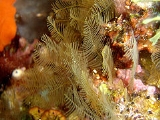
Plumularioidea
Encyclopedia
Plumularioidea are one of the few rather robustly established superfamilies of the cnidaria
n suborder Conica
.
This superfamily unites about 30 genera
in the following families
:
These thecate hydroid
s grow in erect colonies, branched in some species
but unbranched in others. Each branch may bear a single or several animals. In the latter case the hydrothecae are arranged in a neat single file; in either case they are not set on stalks but grow from the branches directly. The hydrothecase have a cusped or even rim and instead of a diaphragm
a well-defined floor with a hydropore that is usually off-center. The hydranths have a conical hypostome
- as is typical for the suborder Conica - and a single whorl of thread-like tentacle
s. The gastrodermis
contains areas with and others without digestive function. Nematophores are always present and usually protected by nematothecae. The gonotheca are borne singly or in groups, they may or may not have protective hydrocladia or appendages. The gonophore
s are usually fixed sporosacs, more rarely they are rather reduced medusoids.
Cnidaria
Cnidaria is a phylum containing over 9,000 species of animals found exclusively in aquatic and mostly marine environments. Their distinguishing feature is cnidocytes, specialized cells that they use mainly for capturing prey. Their bodies consist of mesoglea, a non-living jelly-like substance,...
n suborder Conica
Conica (Hydrozoa)
Conica are a cnidarian suborder of the Leptomedusae . They make up the bulk of their order; their internal relationships are not well resolved, and most of the roughly 30 families are not yet assigned to a superfamily....
.
This superfamily unites about 30 genera
Genera
Genera is a commercial operating system and development environment for Lisp machines developed by Symbolics. It is essentially a fork of an earlier operating system originating on the MIT AI Lab's Lisp machines which Symbolics had used in common with LMI and Texas Instruments...
in the following families
Family (biology)
In biological classification, family is* a taxonomic rank. Other well-known ranks are life, domain, kingdom, phylum, class, order, genus, and species, with family fitting between order and genus. As for the other well-known ranks, there is the option of an immediately lower rank, indicated by the...
:
- Aglaopheniidae Marktanner-Turneretscher, 1890
- Halopterididae
- KirchenpaueriidaeKirchenpaueriidaeThe Kirchenpaueriidae are a hydrozoan family of the superfamily Plumularioidea. Their hydrocladia are characteristically set in an alternating fashion as one progresses along the stems, forming two neat rows except in Oswaldella laertesi, which has three such rows...
- Plumulariidae Agassiz, 1862
These thecate hydroid
Leptomedusae
Leptomedusae or Leptomedusa, commonly called thecate hydroids, are a cnidarian order in the subclass Leptolinae. They were formerly placed at suborder rank in the paraphyletic "Hydroida"...
s grow in erect colonies, branched in some species
Species
In biology, a species is one of the basic units of biological classification and a taxonomic rank. A species is often defined as a group of organisms capable of interbreeding and producing fertile offspring. While in many cases this definition is adequate, more precise or differing measures are...
but unbranched in others. Each branch may bear a single or several animals. In the latter case the hydrothecae are arranged in a neat single file; in either case they are not set on stalks but grow from the branches directly. The hydrothecase have a cusped or even rim and instead of a diaphragm
Diaphragm
-Optics and photography:* Diaphragm , a stop in the light path of a lens, having an aperture that regulates the amount of light that passes* Diaphragm shutter, a type of leaf shutter consisting of a number of thin blades in a camera-Acoustics:...
a well-defined floor with a hydropore that is usually off-center. The hydranths have a conical hypostome
Hypostome
A hypostome , is a calcified harpoon-like structure near the mouth area of certain parasitic arthropods including ticks and mites , that allows them to anchor themselves firmly in place on a host mammal while sucking blood...
- as is typical for the suborder Conica - and a single whorl of thread-like tentacle
Tentacle
A tentacle or bothrium is one of usually two or more elongated flexible organs present in animals, especially invertebrates. The term may also refer to the hairs of the leaves of some insectivorous plants. Usually, tentacles are used for feeding, feeling and grasping. Anatomically, they work like...
s. The gastrodermis
Gastrodermis
The gastrodermis is the inner layer of cells that lines a gastrovascular cavity of Cnidarians....
contains areas with and others without digestive function. Nematophores are always present and usually protected by nematothecae. The gonotheca are borne singly or in groups, they may or may not have protective hydrocladia or appendages. The gonophore
Gonophore
A gonophore is a reproductive organ in Hydrozoa that produces gametes. It is a sporosac, a medusa or any intermediate stage.The name is derived from the Greek words gone and phoreus ....
s are usually fixed sporosacs, more rarely they are rather reduced medusoids.

